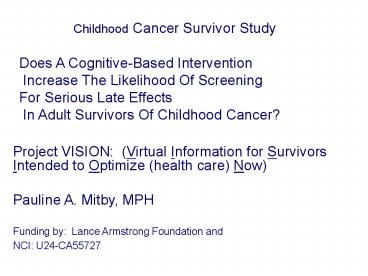Childhood Cancer Survivor Study - PowerPoint PPT Presentation
1 / 24
Title:
Childhood Cancer Survivor Study
Description:
In Adult Survivors Of Childhood Cancer? ... Linking survivor, their health care provider, and cancer center ... intervention designed for Hodgkin survivors ... – PowerPoint PPT presentation
Number of Views:298
Avg rating:3.0/5.0
Title: Childhood Cancer Survivor Study
1
Childhood Cancer Survivor Study
Does A Cognitive-Based Intervention Increase The
Likelihood Of Screening For Serious Late Effects
In Adult Survivors Of Childhood Cancer?
Project VISION (Virtual Information for
Survivors Intended to Optimize (health care)
Now) Pauline A. Mitby, MPH Funding by Lance
Armstrong Foundation and NCI U24-CA55727
2
Childhood Cancer Survivor Study
- Multi-institutional retrospective cohort
- 14,000 survivors enrolled
- Diagnosis between 1970-1986
- Baseline and 3 FU questionnaires
- NCI U24 Resource grant
3
Background
- Childhood cancer survivors at risk for
- Late mortality
- Morbidity
- Adverse health status
Most adult survivors are not seeking/ receiving
risk-based health care
4
Cancer Center Visits and Late Effects
Percent
5 10 15
20 25
Years since cancer diagnosis
5
Cancer Center Visits and Late Effects
Percent
5 10 15
20 25
Years since cancer diagnosis
6
Project VISION
- Funded by LAF
- Two-year pilot in CCSS
- Linking survivor, their health care provider, and
cancer center - Tested in 72 high-risk Hodgkin survivors 25
years of age - Females at risk for breast cancer
- Males and females at risk for cardiac disease
7
Specific Aims
- Pilot test a cognitive-based intervention
designed for Hodgkin survivors - a medical summary with screening recommendations
- a virtual information center
- Determine proportion of eligible survivors and
health care providers who - enroll
- complete the study
8
Project VISION
Virtual Team -Physicians -Nurses/NP -Social
Workers
Virtual Center Web/1-800 - Information -
Resources - Communication
Survivors Health Care Providers
Virtual Center Interventionist
9
Project VISION
72 HCP
72 HD
Baseline Information seeking practices Patient
Satisfaction with Physician Profile of Moods
(POMS)
Baseline Knowledge of late effects Screening
guidelines
Intervention Medical Treatment Summary Website ID
/ 1-800
Intervention Website ID / 1-800
6 Months Telephone Interview
6 Months Telephone Interview Profile of Moods
(POMS)
10
(No Transcript)
11
(No Transcript)
12
(No Transcript)
13
(No Transcript)
14
Enrollment
- 72 HD survivors invited to participate
- Females at risk for breast cancer
- Males and females at risk for CD
- Had not had mammogram or echo in previous two
years - 61 (85) survivors enrolled
- 9 physicians enrolled
- No physician involvement past enrolling
- 56 (92) survivors completed 6 month phone survey
15
Study Population
16
ResultsPOMS - Baseline
17
ResultsPOMS pre vs. post test
18
ResultsIntervention Materials
19
ResultsMedical Treatment Summary
20
Results Screening Recommendations
21
Conclusions
- Receiving a cancer treatment summary years after
therapy was positively received - Most of this high risk group were not aware of
the recommendations for screening or follow-up
care - Simple cognitive-based intervention appears to be
effective in promoting action
22
Conclusions
- Components that did not add to intervention
- Web-based information center
- Little use of interactivity (posted questions)
- Information was personalized to the cancer (HD),
not to the individual - Cost Benefit
- Lack of physician involvement
- May reflect busy practice
23
Future Directions
- Formal 3-arm randomized clinical trial to test
the effectiveness and sustainability of
interventions - Standard practice
- Medical summary and recommendations
- Behaviorally-based tailored intervention in
addition to medical summary - Assess other ways to engage primary care
physicians
24
Project VISION
- Investigators
- Kevin Oeffinger
- Ann Mertens
- Melissa Hudson
- Debra Eshelman
- Pauline Mitby
- Christine Jacox
- Laura Snell
- Consultants
- Judith Jones
- Sharmila Kamani
- Netesolutions
- VISION clinical team
- Principal Investigator































